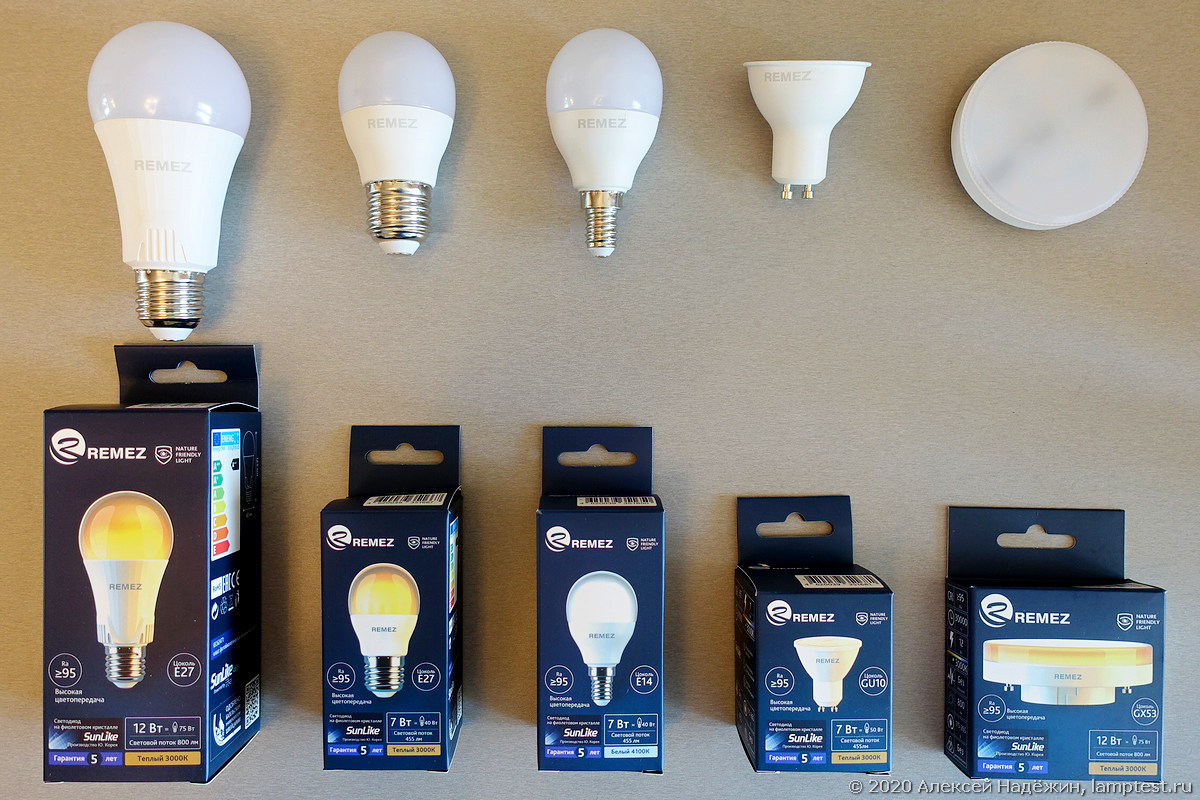
Conventional LED lamps use LEDs with crystals emitting blue light. The crystal is coated with a two-component phosphor that converts blue light into white (one component adds the red part of the spectrum, the other adds green, and blue light filters through the phosphor). Seoul Semiconductor's Sunlike LEDs use crystals that emit violet light and a three-component phosphor that produces the red, green and blue portions of the spectrum. Such LEDs have less efficiency (the number of lumens per watt), but the spectrum is even and all colors are transmitted perfectly (I talked about this technology: https://habr.com/ru/company/lamptest/blog/411021) .
In January 2020, eight models of Remez lamps with Sunlike LEDs (https://habr.com/ru/company/lamptest/blog/488278 ). Were released "pears" 7 and 9 W (420 and 540 lm) and "candles" 5 and 7 W (300 and 420 lm) with a color temperature of 3000K and 5700K.
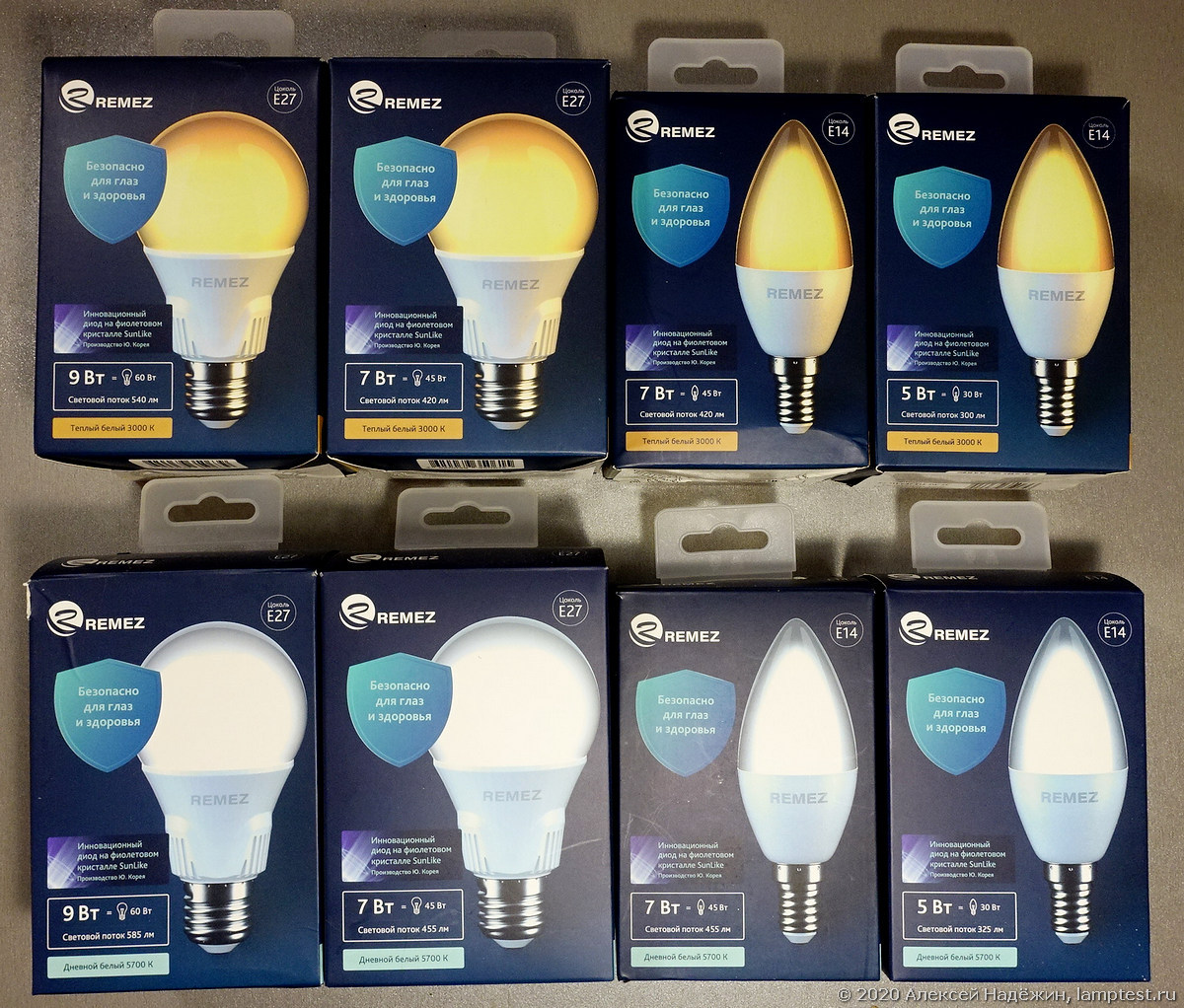
The new series includes “pears” 12 W (800 lm), “G45 balls” 7 W (455 lm) with E27 and E14 bases, 7 W GU10 lensed spots and 12 W “GX53 tablets”. Color temperatures are now 3000K and 4100K (many have complained that 5700K is too cold light). The G45 bulb with E14 socket is only produced with 4100K neutral light.
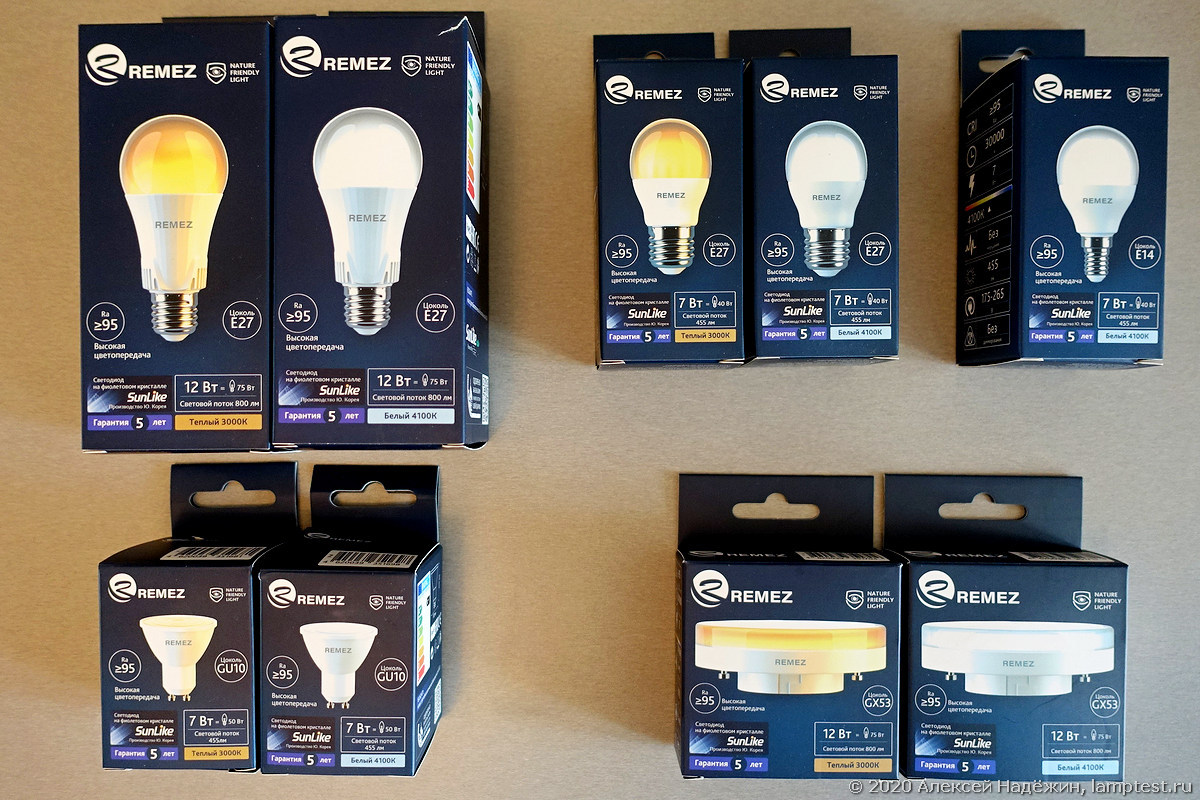
Most of the LED spots with GU10 and GU5.3 caps have a matt diffuser and a light launch angle of about 100 °. This leads to the fact that such spots are "blind" (I wrote about this problem: https://habr.com/ru/company/lamptest/blog/391349 ). To avoid the glare effect, the spot illumination angle should be narrow (up to 50 °), for this, instead of a matt diffuser, the lamp should have a lens that narrows the light beam. These are the lenses that Remez lamps use.
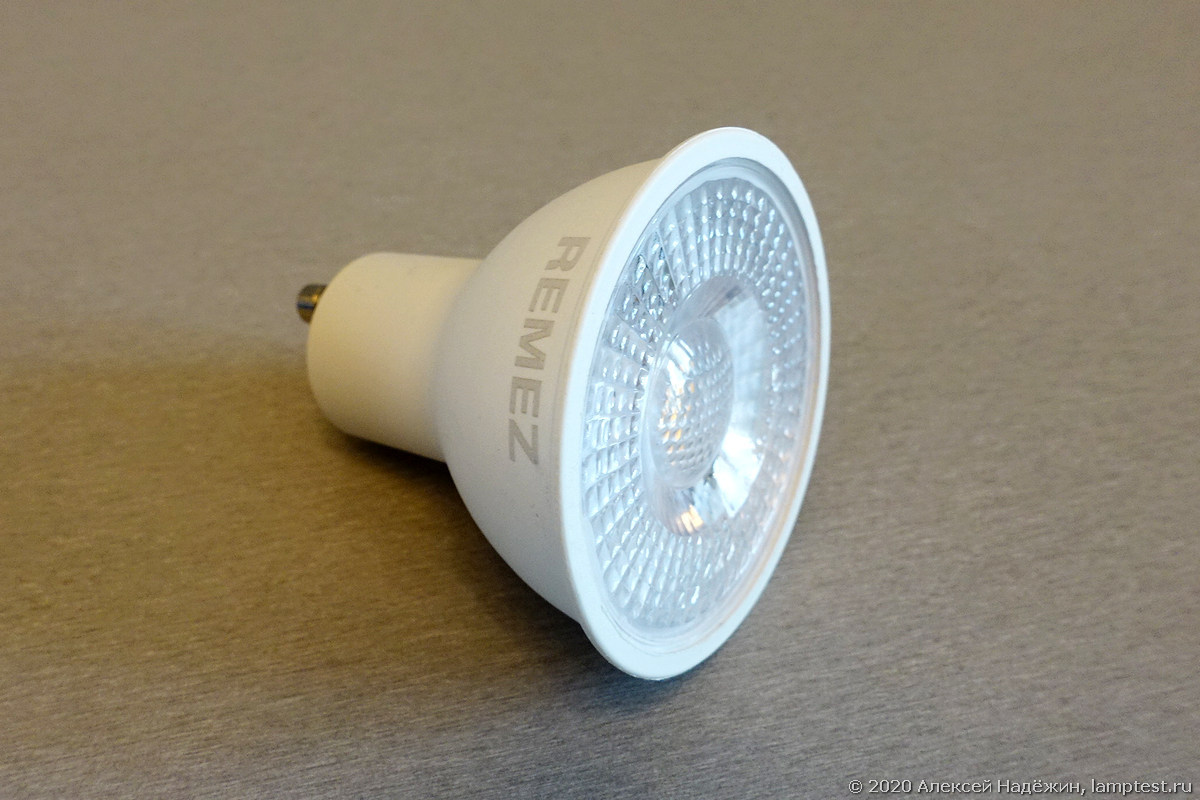
New lamps cost from 399 to 735 rubles. Of course it's expensive for regular LED bulbs, but for Sunlike bulbs the prices are great.
The first thing I did was make sure the LEDs in the new lamps are still Sunlike. As an example, I will give the spectra of 12 W "pears" with color temperatures of 3000K and 4100K. The spectra are ideal, all indices are very high.
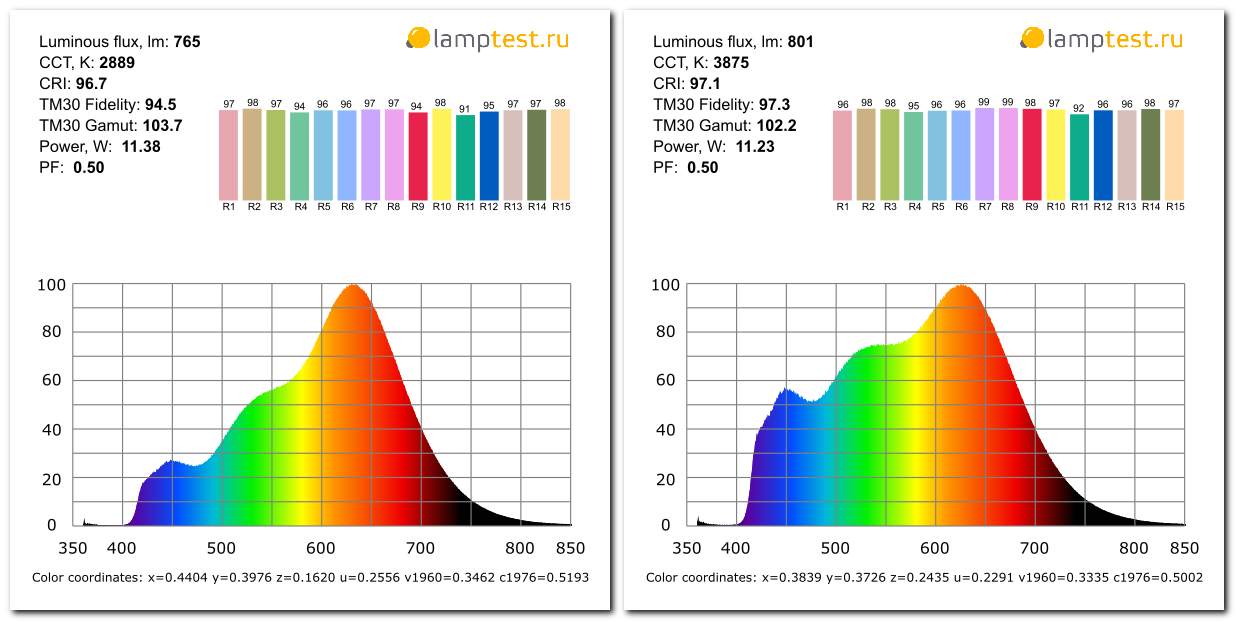
I tested two copies of new lamps, I will give all the results.
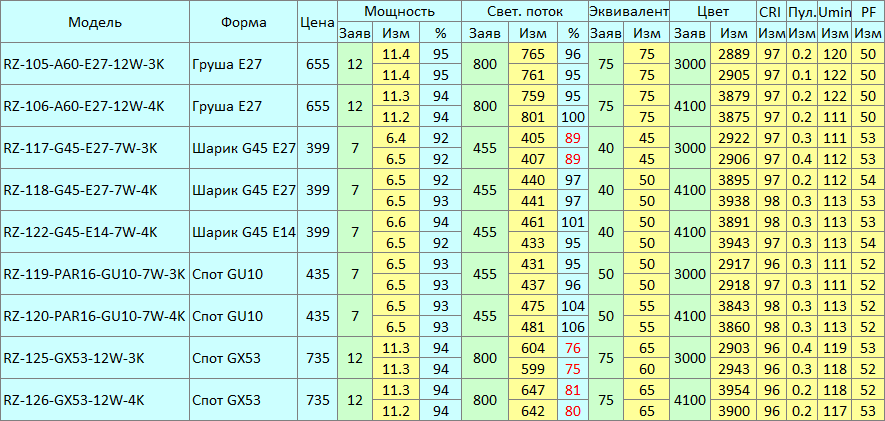
All lamps have very high CRI (Ra) color rendering indices - 96-98, there is no light pulsation (the ripple coefficient is not higher than 0.4%).
Lamps work correctly with switches that have an indicator (they do not flash or light when such a switch is turned off).
All lamps are built on IC drivers and actually have a built-in stabilizer - their brightness does not change when the mains voltage changes over a very wide range and does not react to voltage surges (the lower voltage limit is indicated in the Umin column and is 111-122V).
The measured color temperature of lamps with warm light was about 2900K, lamps with neutral light about 3900K.
The measured power of all lamps differs from the declared one by no more than 0.8 W.
The measured luminous flux for most lamps is close to the declared one. For GU10 spots with neutral light, it is even higher by 4-6%. G45 bulbs with warm light give 11% less light than stated (405-407 lumens instead of 455 lm), but this is enough to fully replace a 40-watt incandescent lamp. The measured luminous flux of "tablets" GX53 turned out to be lower than the declared one by 20-25% ("warm" give about 600 lm, "neutral" about 650 lm, and 800 lm is declared).
Luminous flux, color temperature and color rendering index were measured using a two-meter integrating sphere and an Instrument Systems CAS 140 CT spectrometer, power consumption and power factor with a Robiton PM-2 instrument, and ripple with an Uprtek MK350D instrument. The minimum operating voltage, at which the luminous flux decreased by no more than 5% of the nominal, was measured using a Lamptest-1 device, a Shtil Instab 500 stabilizer and a Suntek TDGC2-0.5 LATRa. To stabilize the parameters, the lamps were warmed up for half an hour before measurements.
Russia is in many ways ahead of other countries in LED lighting (everyone who has visited hardware stores in other countries can confirm this) and it seems to me very indicative that the world's only serial household lamps with a solar spectrum are produced by a Russian company. By the way, she also produces table lamps based on Sunlike LEDs (I told about them: https://habr.com/ru/company/lamptest/blog/437276 ).
It was a mystery to me why the Chinese did not start producing similar ones (after all, these lamps are also produced in China). The secret turned out to be simple: Russian entrepreneurs chose a Chinese factory that produces ordinary high-quality lamps (it is even indicated on the packaging of Remez: Shanghai Wellmax Lighting lamps), and then they bought LEDs from the Korean Seoul Semiconductor and brought them to the factory so that not ordinary Chinese ones could be installed in the lamps LEDs, as in the rest of the plant's products, are Sunlike.
The manufacturer gives a 5 year warranty for all Remez lamps and indicates a service life of 30,000 hours.
After the release of the first lamps, a review appeared on the Internet that these lamps burn out after 500 hours. Just in case, I turned on two lamps for 1000 hours - a 9 W pear and a 7 W candle. Both did not burn out. In any case, there is a guarantee and if the lamps fail earlier than five years later, you can contact the store or the manufacturer and replace them.
Remez lamps are sold on the manufacturer's website , in the Ozone and Wildberries online stores. You can see the light bulbs "live" in RegenBogen stores.
© 2020, Alexey Nadezhin